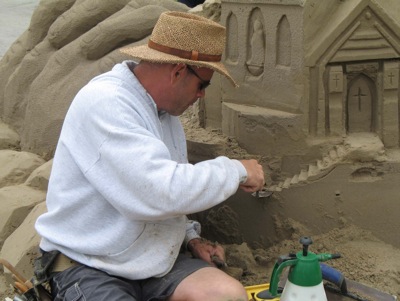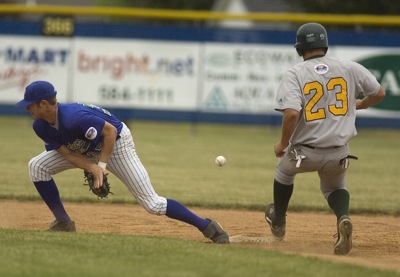Monday, June 25th, 2007
Twelve tons - and what do you get?
By Margie Wuebker

Photo by Margie Wuebker/The Daily Standard
Master sand sculptor Ron McDonald adds the finishing touches to steps on a church he and Laurie Tournoux created during the 20th annual Maria Stein Country Fest held during the weekend. The overall design depicts the once-popular finger play "Here's the church, here's the steeple."
MARIA STEIN - Laurie Tournoux and Ron McDonald put on quite a show at the 20th annual Country Fest turning 10 to 12 tons of sand into a work of art.
The master sand sculptors set to work Friday afternoon and finished just before noon Sunday, sharing an enthusiastic high five as they viewed their handiwork - a massive pair of hands folded in prayer and a church with towering steeple atop a rock foundation.
For their second visit to the festival held on the grounds of the Shrine of the Holy Relics, the pair chose a once popular hand play that goes "Here is the church, here is the steeple, open the doors and see all the people" as the theme.
A piece of bright red Duct tape on the brick-lined sand pit shows visitors where to stand in order to look through two fingers raised steeple fashion and see the church. Little sand people stand ready to enter the doors represented by a pair of crossed thumbs.
"It has been interesting," Tournoux says brushing a strand of hair from her eyes. "The rhyme was something all of us did as kids, but it seems to have fallen by the wayside like so many other things."
Many onlookers believe the work depicts the shrine chapel located off St. John Road, but that assumption is partly correct. After last year's festival the sculptors toured the area known for its cross-tipped churches and took photographs.
"This design actually includes elements from six area churches including the chapel over there," Tournoux says.
How does one begin to create a sand masterpiece standing 12 feet tall or so? The master sculptors, two of just 150 worldwide, resemble youngsters building sand castles at the start.
The process known as pounding up involves filling large molds with four inches of sand and then liberally topping the material with water that is quickly absorbed. The blocks are stacked one on top the other around the sand pit.
"We shovel, tamp and then saturate the sand," she says. "We're like a couple of kids. However, our buckets or molds don't have bottoms. The sand comes out perfectly without falling apart."
Their tools include trowels in a variety of sizes, sprayers for rehydrating the sand, paintbrushes for removing loose sand, sturdy shovels and even Duct tape.
"Duct tape is a girl's best friend," Tournoux says displaying an injured finger shrouded in blue tape. "You never know when you're going to need it, and all the different colors provide added interest."
The graded and quarried sand from neighboring Shelby County is a far cry from run-of-the-mill beach sand. A byproduct of masonry sand, it has a silt-like consistency and noticeable clay content free of pebbles and debris.
"You never know what little surprises beach sand holds," McDonald says removing his straw hat long enough to wipe a sweaty brow. "You can be carving away and suddenly reveal a cigarette butt, seaweed or even a shard of driftwood. Those things are definitely not part of the game plan."
Both artists admit the pounding up process is the most difficult - something that must be done before they embark on carving.
"We pound up the sand and then we carve away the excess," Tournoux says without looking up from the work at hand. "Occasionally you wind up carving away a little too much or there is a small collapse. You learn to work around those things without making a fuss. The high clay content makes such mishaps repairable."
Mother Nature smiled favorably and sent rain in sufficient quantities to ensure the sand remained moist. They normally have to spray on a concoction of water and 10 percent Elmer's Glue to hold in moisture but skipped the process this time.
"People assume rain damages sand sculptures," she says. "Sun and wind are the threats because sun dries the sand and wind blows it away. Rain is good ... we kept right on working as onlookers huddled under umbrellas."
The only negative result from the prolonged rainfall was a 3-inch shift in the overall design and a resulting crack in one of the hands. The sculptors expect the hand will crumble first but that could take place weeks or even months from now.
The friends, who have been working together for seven years, do sand sculpting on a part-time basis. She lives in Louisville, south of Cleveland, and works as a city tax administrator. McDonald, an Enon native and current Florida resident, is a senior art designer at Walt Disney World involved in animatronics at the Animal Kingdom.
"Sand sculpting is really a performance art," Tournoux says. "Sand sculptors have creative control on somebody else's dime and the ability to talk as they work. You always have a crowd and where else can do what you love and feel the soft sand between your toes at the same time?"

Photo by Margie Wuebker/The Daily Standard
Master sand sculptor Ron McDonald adds the finishing touches on a church he and Laurie Tournoux created during the 20th annual Maria Stein Country Fest held during the weekend. The overall design depicts the once-popular finger play "Here's the church, here's the steeple."


